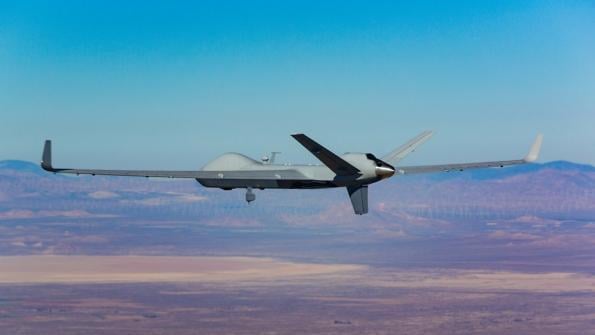
The U.S. Air Force is on the hunt for attritable aircraft to round out its inventory, but the service may already have what it needs in the MQ-9, according to the manufacturer.
The MQ-9 greatly differs from a manned, aluminum aircraft because it is composed of composite material. This means the avionics, advanced sensors and other equipment can easily be upgraded over time.
Some of the MQ-9s flying today have more than 30,000 flight hours with mission capable rates of 90% or higher, General Atomics Aeronautical Systems President David Alexander confirmed in a statement to Aerospace DAILY.
“When compared to the acquisition, maintenance and missions costs of traditional widebody metal [intelligence, surveillance and reconnaissance] aircraft, those 30,000-plus flight hours represent a tremendous value that makes service-life extension unnecessary,” Alexander said.
The service currently has 315 MQ-19s in its inventory pegged at a flyaway cost of $17.7 million, according to Aviation Week’s Intelligence and Data Services. Under a high operational tempo, 30,000 flight hours translate to somewhere between eight to nine years of service.
“A formal service life extension program would not be practical because the MQ-9 per-unit replacement cost is affordable and would address any diminished manufacturing supply issues,” Alexander said in a statement.
In a war with China and Russia, Thomas Mahnken, Center for Strategic and Budgetary Assessments president and chief executive officer, estimates a constant presence of 39 MQ-9s will be needed. He outlined the proposal in an April report, “Deterrence by Detection: A Key Role for Unmanned Aircraft Systems in Great Power Competition.”
Mahnken would have MQ-9s patrolling the Spratly Islands, Senkaku Islands, Taiwan Strait, and Kaliningrad, and be available for surge missions.
“While there is great debate about survivability and operations in contested airspace for the MQ-9, seldom are these issues framed specifically in terms of unmanned aircraft advantages overall or current employment of MQ-9s around the world,” Alexander said.
General Atomics customers are not risking the lives of their personnel, but only the loss of an “affordable” aircraft, he added.
“This flexibility gives commanders the option of exposing the MQ-9 to scenarios no manned aircraft is likely to face,” Alexander said. “The MQ-9 already has a great track record of success in these tough situations, to the benefit of the mission and with the added bonus of protecting lives.”

Comments